eMMC vs. SSD storage: What's the difference?
Ghana
5
eMMC vs. SSD storage: What's the difference?
Going through a friends lap today trying to help with an issue, I noticed his lap had an eMMC storage. I knew of HDD and SSD storage, but I'd never heard of eMMC. I decided to find out about this eMMC storage and share with you.
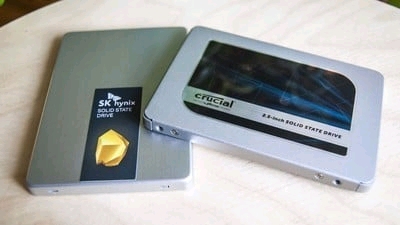
Source: Windows Central
Best answer: Embedded MultiMediaCard (eMMC) and solid-state drive (SSD) storage have a lot in common, including the use of NAND flash memory. However, SSDs almost always deliver superior performance and are available in far larger sizes for bulk storage. In most cases, if you're not shooting for a budget PC, we recommend opting for an SSD over eMMC storage.
What is eMMC storage?
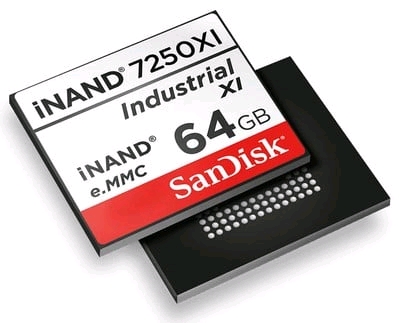
MultiMediaCard (MMC) storage was the precursor to what is commonly known as Secure Digital (SD) storage. MMC still exists in multiple forms, but you'll likely find its embedded version (eMMC) most commonly.
eMMC storage is mostly found in phones, as well as some of the best cheap laptops. The "embedded" part of the name comes from the fact that the storage is usually soldered directly onto the device's motherboard. eMMC storage consists of NAND flash memory — the same stuff you'll find in USB thumb drives, SD cards, and solid-state drives (SSD) — which doesn't require power to retain data.
The low-cost nature of eMMC storage makes it ideal for cost-effective hardware, including truly budget PCs. However, it's also found in premium devices like the Surface Go 2.
How fast is eMMC storage?
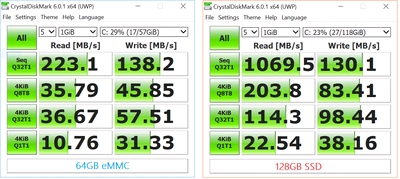
Speed difference between 64GB eMMC and 128GB SSD in the Surface Go.
The current standard for eMMC storage is v5.1A, which can effectively deliver transfer speeds of up to about 400MB/s. That's not necessarily slow, and SATA SSDs will top out around the same.
However, it's not just the overall transfer rate that determines how a device's performance will be affected. eMMC storage usually operates with fewer memory gates than an SSD, meaning it can still deliver at the same speed, just not at the same volume.
Think of it like a road — the more lanes there are, the more cars you can move at a time. eMMC is a single lane each way, while an SSD is a multi-lane highway. You'll go the same speed on either one, but the on-ramp to get onto the road won't be nearly as slow on the highway.
If you'd like storage that can deliver data as fast as possible, you'll want to check out a PCIe NVMe SSD. Some of the best SSDs can reach read speeds up to 3,500MB/s on the PCIe 3.0 standard, while the latest PCIe 4.0 standard nearly doubles the speed. Write speeds are a bit slower in both cases, but still much, much faster than eMMC storage. Check out our review of the XPG Gammix S70 PCIe 4 SSD for more information.
How big does eMMC storage get?
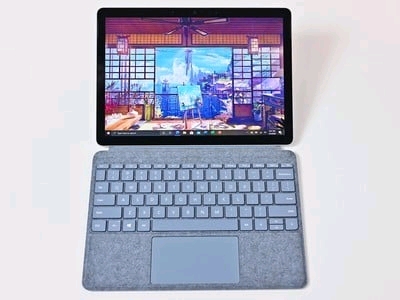
Source: Windows Central
Surface Go 2 uses eMMC storage in its baseline configuration.
If you've been shopping for a budget laptop or tablet, you've no doubt noticed that many come with either 32GB or 64GB storage. These are the most common sizes of eMMC storage, but you can also find 128GB and 256GB storage. eMMC storage works best with small file sizes (those lanes on the road don't jam up as easily), so if you're often working with large files, you'll no doubt want to look at an SSD.
SSDs are available in much larger sizes, usually from 128GB all the way up to multiple terabytes. They are also usually considerably more expensive. If you're looking at an eMMC drive, always factor in the cost of the cloud storage fees you'll no doubt end up paying for in the end. Sizes like 32GB and 64GB just don't hold up anymore; if the price of cloud storage will come out somewhere around the price of an SSD, you might just be tempted to pay more up front and not worry later.
There's also the matter of upgrading your own PC after purchase. The "embedded" part of eMMC storage means you're not going to be replacing anything, whereas many laptops (not all) have an accessible M.2 slot. This allows you to choose a smaller SSD, saving money at checkout. You can wait for a sale on your preferred storage and upgrade at your leisure, expanding storage without much trouble.
Should you avoid eMMC storage?
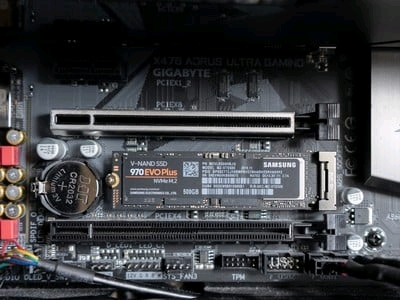
Cheaper, smaller eMMC storage isn't necessarily bad. There's definitely a market for it, especially in the budget laptop category with devices like Microsoft's Surface Laptop Go. As far as durability goes, you'll no doubt see a display or touchpad crap out way before eMMC storage degrades to an unusable condition.
Whether or not you should avoid eMMC storage is more based on your budget and what you're using your device for. If you need a tablet or affordable notebook for browsing the internet and watching some streaming media, eMMC storage should be just fine. Keep in mind that eMMC storage is not all made the same, and you'll no doubt want to check reviews for speed benchmarks before making a final decision.
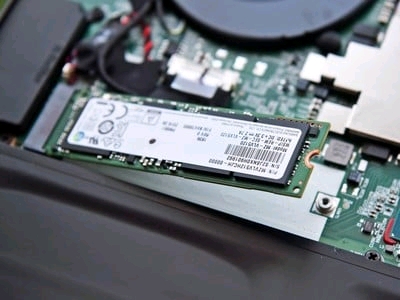
If you plan on using a laptop for pretty much anything else — including gaming and productivity — you'll no doubt benefit from an SSD. Like eMMC storage, not all SSDs are made the same, and there is plenty of slow hardware out there. Read reviews and check benchmarks to ensure you're getting a drive with the speed you require. Our collection of the best SSDs has a bunch of great options.
A hard-disk drive (HDD) is also an option, especially if you're dealing with large file sizes, but in general you'll be much more satisfied with an SSD.
#TechNewsPurple
A few things to note:
• eMMC storage is not upgradable
• eMMC storage can not be replaced with SSD.
• The highest storage for eMMC is 64gb
#PurplesInn
Going through a friends lap today trying to help with an issue, I noticed his lap had an eMMC storage. I knew of HDD and SSD storage, but I'd never heard of eMMC. I decided to find out about this eMMC storage and share with you.

Source: Windows Central
Best answer: Embedded MultiMediaCard (eMMC) and solid-state drive (SSD) storage have a lot in common, including the use of NAND flash memory. However, SSDs almost always deliver superior performance and are available in far larger sizes for bulk storage. In most cases, if you're not shooting for a budget PC, we recommend opting for an SSD over eMMC storage.
What is eMMC storage?

MultiMediaCard (MMC) storage was the precursor to what is commonly known as Secure Digital (SD) storage. MMC still exists in multiple forms, but you'll likely find its embedded version (eMMC) most commonly.
eMMC storage is mostly found in phones, as well as some of the best cheap laptops. The "embedded" part of the name comes from the fact that the storage is usually soldered directly onto the device's motherboard. eMMC storage consists of NAND flash memory — the same stuff you'll find in USB thumb drives, SD cards, and solid-state drives (SSD) — which doesn't require power to retain data.
The low-cost nature of eMMC storage makes it ideal for cost-effective hardware, including truly budget PCs. However, it's also found in premium devices like the Surface Go 2.
How fast is eMMC storage?

Speed difference between 64GB eMMC and 128GB SSD in the Surface Go.
The current standard for eMMC storage is v5.1A, which can effectively deliver transfer speeds of up to about 400MB/s. That's not necessarily slow, and SATA SSDs will top out around the same.
However, it's not just the overall transfer rate that determines how a device's performance will be affected. eMMC storage usually operates with fewer memory gates than an SSD, meaning it can still deliver at the same speed, just not at the same volume.
Think of it like a road — the more lanes there are, the more cars you can move at a time. eMMC is a single lane each way, while an SSD is a multi-lane highway. You'll go the same speed on either one, but the on-ramp to get onto the road won't be nearly as slow on the highway.
If you'd like storage that can deliver data as fast as possible, you'll want to check out a PCIe NVMe SSD. Some of the best SSDs can reach read speeds up to 3,500MB/s on the PCIe 3.0 standard, while the latest PCIe 4.0 standard nearly doubles the speed. Write speeds are a bit slower in both cases, but still much, much faster than eMMC storage. Check out our review of the XPG Gammix S70 PCIe 4 SSD for more information.
How big does eMMC storage get?

Source: Windows Central
Surface Go 2 uses eMMC storage in its baseline configuration.
If you've been shopping for a budget laptop or tablet, you've no doubt noticed that many come with either 32GB or 64GB storage. These are the most common sizes of eMMC storage, but you can also find 128GB and 256GB storage. eMMC storage works best with small file sizes (those lanes on the road don't jam up as easily), so if you're often working with large files, you'll no doubt want to look at an SSD.
SSDs are available in much larger sizes, usually from 128GB all the way up to multiple terabytes. They are also usually considerably more expensive. If you're looking at an eMMC drive, always factor in the cost of the cloud storage fees you'll no doubt end up paying for in the end. Sizes like 32GB and 64GB just don't hold up anymore; if the price of cloud storage will come out somewhere around the price of an SSD, you might just be tempted to pay more up front and not worry later.
There's also the matter of upgrading your own PC after purchase. The "embedded" part of eMMC storage means you're not going to be replacing anything, whereas many laptops (not all) have an accessible M.2 slot. This allows you to choose a smaller SSD, saving money at checkout. You can wait for a sale on your preferred storage and upgrade at your leisure, expanding storage without much trouble.
Should you avoid eMMC storage?

Cheaper, smaller eMMC storage isn't necessarily bad. There's definitely a market for it, especially in the budget laptop category with devices like Microsoft's Surface Laptop Go. As far as durability goes, you'll no doubt see a display or touchpad crap out way before eMMC storage degrades to an unusable condition.
Whether or not you should avoid eMMC storage is more based on your budget and what you're using your device for. If you need a tablet or affordable notebook for browsing the internet and watching some streaming media, eMMC storage should be just fine. Keep in mind that eMMC storage is not all made the same, and you'll no doubt want to check reviews for speed benchmarks before making a final decision.

If you plan on using a laptop for pretty much anything else — including gaming and productivity — you'll no doubt benefit from an SSD. Like eMMC storage, not all SSDs are made the same, and there is plenty of slow hardware out there. Read reviews and check benchmarks to ensure you're getting a drive with the speed you require. Our collection of the best SSDs has a bunch of great options.
A hard-disk drive (HDD) is also an option, especially if you're dealing with large file sizes, but in general you'll be much more satisfied with an SSD.
#TechNewsPurple
A few things to note:
• eMMC storage is not upgradable
• eMMC storage can not be replaced with SSD.
• The highest storage for eMMC is 64gb
#PurplesInn
Comments (5)
0/500
New Comments(5)
DayLight music
Kanye West update
so interesting
Boom Technology
Wow that's awesome
nice